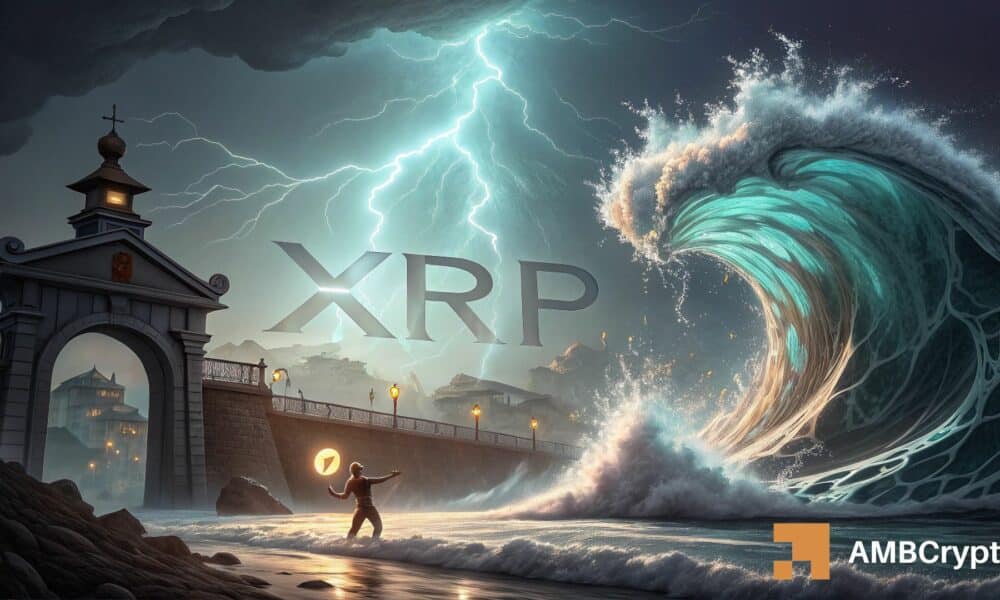Key takeaways
Does the 92.6 million inflow increase near-term supply pressure for XRP?
The transfer of whales adds immediate supply in the event of a stock market crash, increasing volatility and calling into question short-term stability despite falling foreign exchange reserves.
Do market metrics show sufficient support to offset the impact of capital inflows?
Strong Taker Buy dominance, declining reserves, and reduced leverage help ease downward pressure and create potential areas of stability.
A massive inflow of 92.6 million Ripple (XRP) entered Coinbase during an aggressively bearish market cycle, and this timing increases near-term uncertainty for XRP price outlook.
Large transfers to exchanges create immediate supply-side leverage, as whales typically move tokens as they prepare to reposition, hedge, or de-risk during extreme volatility. The stock market crash amplifies this effect, making traders much more reactive to any liquidity shock.
This influx also introduces higher risks of rapid order book imbalances, which can trigger deeper declines if buyers fail to absorb sudden supply.
However, the reaction depends on whether this transfer reflects a strategic redistribution or a real sales intention.
XRP exchange reserves are decreasing!
Foreign exchange reserves fell almost 9% at press time, and this decline provides a stark contrast to the short-term inflow pressures created by the whale trade.
Tokens leaving exchanges typically evidence accumulation behavior, and this trend strengthens during major corrections as confident holders buy aggressively.
Such withdrawals reduce the amount of XRP available for immediate sale, which naturally compresses supply and stabilizes downward volatility.
The continued decline also demonstrates resilience, as holders resist panic selling even during violent market swings. Many traders view this as a constructive long-term development, especially when market fear is at a fever pitch.
Even if inflows introduce temporary risk, the decline in reserves counteracts this by creating structural support. If the reserve trend continues, XRP could maintain its underlying strength despite near-term turmoil.


Source: CryptoQuant
Taker Buy’s Dominance Shows Bulls Still Stepping In
Spot Taker Buy CVD indicates strong buyer aggressiveness over the past 90 days, and this behavior persists even as volatility increases in the market.
Buyers actively lift sell orders, showing a clear willingness to accumulate during periods of fear. This absorption helps slow down bearish momentum as it limits the impact of sudden entries such as the transfer of 92.6 million XRP.
Strong CVD behavior also indicates that demand remains engaged, which is unusual during severe crashes where buyers typically pull back. However, sustained selling pressure may further test buyer resistance if inflows increase.
Traders are now watching to see if this buyer dominance continues, as it determines whether XRP forms a defensive floor. Continued strength here could significantly blunt the impact of external bearish forces.


Source: CryptoQuant
XRP NVT Ratio Increases as Valuation Stretches During Reduced Network Activity
At the time of writing, the NVT ratio has increased by over 11%, and this jump highlights a potential valuation imbalance for XRP.
High NVT values often appear when market capitalization exceeds trading volume, suggesting that price remains stronger than underlying network activity.
During a stock market crash, such peaks deserve attention, because the decline in activity associated with rising valuation indicators creates a risk of overextension.
Additionally, high NVT ratios may precede local corrections, particularly when market conditions weaken.
Traders are now watching to see if volume rebounds enough to justify the high reading, or if NVT continues to climb into risk-off territory.
However, NVT can remain high during accumulation phases, complicating interpretation. The current peak therefore serves more as a signal of caution than as a direct bearish trigger.


Source: CryptoQuant
A sharp decline in open interest issues…
At the time of writing, Open Interest (OI) has fallen by more than 13%, and this contraction reflects a widespread unwinding of leveraged positions as volatility intensifies.
Traders quickly reduce their risk exposure during extreme swings, and this behavior removes bull and bear leverage from the market.
Lower OI often leads to more stable price action because fewer liquidations occur, reducing forced volatility spikes.
However, it also decreases speculative momentum, which limits strong directional moves. The decline in OI demonstrates that traders prefer safety until market conditions stabilize, especially as whale influxes increase uncertainty.
A continued decline suggests an environment dominated by caution, while a sudden rebound could signal renewed confidence and directional conviction. Traders now use OI as an indicator of upcoming phases of volatility.


Source: CryptoQuant
In summary, XRP finds itself at a critical crossroads as the influx of 92.6 million whales collides with declining foreign exchange reserves, high buyer absorption, and reduced leverage activity.
The data creates a mixed environment, but Taker Buy’s long-term accumulation and consistent strength provides some stability. XRP’s next direction now depends on how the market digests the sudden spike in supply during an already intense crash.




